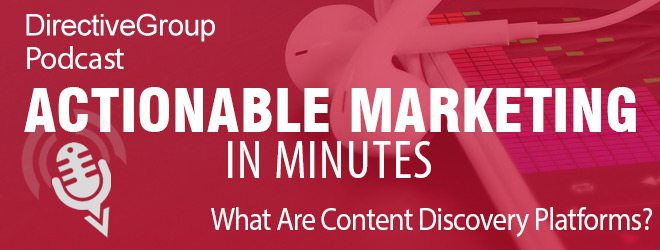In this episode of Actionable Marketing In Minutes we talk about content discovery platforms and how you can use them to enhance your marketing campaign.
Use the player below to listen to this episode, or the download link to load it on your device for listening later. You can also find our RSS feed by clicking here, or subscribe by email in the sidebar to the left.
Download our Marketing To Millennials eBook here!
Not able to listen? Why not read the episode transcript below:
Problem:
Over the past year or two there has been significant traffic growth on Content Discovery Networks. This growth has been driven by the functionality that makes presenting content to new viewers much more efficient. Content Discovery Networks are sometimes called “Content Recommendation Engines,” and are ad networks that place ads in the “Around the Web” and “Recommended Stories” sections commonly found on large publishers and news sites such as CNN, Slate.com, and Inc.com. It is another place an advertiser can present their messaging alongside other relevant content. A content discovery platform utilizes user metadata in order to discover and recommend appropriate content for the viewer and serves up the appropriate messaging for that person. This is a very new avenue for marketers, and for many they do not even know where to start, or how to be effective with Content Discovery Networks.
Solution: Content Discovery Networks are effective in almost any market. Here are the different types of advertisers who are currently seeing the most success:
1. Direct Response/Lead Generation: Direct response and lead generation companies use Content Discovery Networks to send traffic to video sales letters, native ads and pre sell pages. 2. B2B/B2C SaaS Software: Large advertisers are using Content Discovery Networks to drive traffic to blog posts or whitepaper downloads that address some specific issue their prospects/customers might be having. 3. Viral News/Quiz Sites: Viral news and quiz sites are the biggest advertisers on Content Discovery Networks. Often they offer two rates: one rate for advertisers sending traffic to sales pages and a lower rate for advertisers sending traffic to pure content such as news and quiz sites, so this can be very cost-effective for those with cute quizzes or checklists.
Sharing your content through these content discovery services can get your business some great exposure on top sites, but beyond the exposure, these platforms can help increase traffic to your website and lead generation numbers.
Here are our suggestions on how to set up and optimize your content discovery campaigns, and get the biggest bang for your buck:
1) Plan Ahead: Before jumping in and beginning your campaigns, the first thing you should do is identify your objectives. Are you focused on generating new sales leads, or are you trying to drive as much traffic to your site as possible? Perhaps your goal is to grow brand identity. By clearly stating your goals, you with better be able to stay focused on the objective of your campaigns throughout the setup and optimization process.
2) What is your Message & Content: Once you’ve identified your goals, you should look through your content pieces, (blogs, podcasts, etc.) and decide which ones will be the best fit for this platform. Pro Tip: given that the nature of this service is to recommend other content at the bottom of blog posts, a best practice is to directly direct these readers to your own content (like a blog), instead of something they would need to download, such as an ebook – more on that in a minute.
3) Optimize for Conversion: You can generate leads without sending viewers directly to your landing pages with lead capture forms… You do this by optimizing your blog posts with compelling content and calls-to-action to download your ebooks. It takes an extra step, but your will have a higher conversion rate. Make sure that the content of the ebooks you’re promoting and the topic of your blog posts are closely tied and valuable to the visitor. Remember to include links to your lead gen content throughout your blog content, and use a larger visual call-to-actions at the end of your blog posts giving the user a logical “next step”.
4) Upload your Content and Create Variations: When you have your list of pieces to promote, upload the URLs to the platform. Whenever possible you will want to take advantage of tracking, so don’t forget to include tracking tokens. Also, you have the opportunity to create numerous variations for the titles of your blog posts, which will appear when they are promoted. Always test and measure. You’ll be able to see which titles are performing best and pause the ones that are not.
5) Track performance and optimize for your goals: Often people’s eyes glaze over a bit when looking at analytics – but it is important to understand what you are tracking and how these performance metrics are tied to your goals — number of views, clicks, leads, and time on site, all matter. As you gain comfort, you can begin to optimize your campaigns toward those goals by testing new content and titles, and shift your spend appropriately.
Benefits:
The digital marketing landscape is evolving rapidly and the only thing we know for sure is that we’re just seeing the beginning of a whole new brand of advertising. Anyone who is looking for another great traffic source should really consider testing out a few campaigns on these networks, and see if it works for your business and brand.
We hope you’ve found this information helpful. Please connect with us on Twitter @DirectiveGroup or on LinkedIn. Let us know what you think and what you’d like to hear about next. And if you like our podcasts please share with your networks using hashtag #actionablemarketing.
Join us for an upcoming episode as we discuss review sites, and why more is better.
Podcast: Play in new window | Download (Duration: 7:13 — 3.0MB) | Embed
